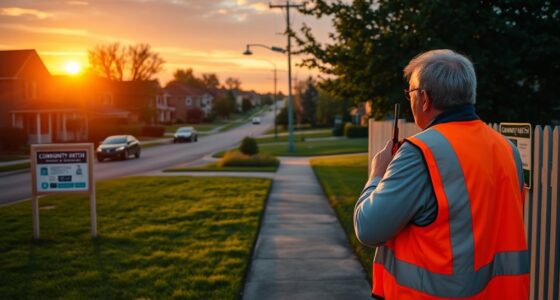To measure your home safety checklist correctly, systematically inspect each area for potential hazards. Check the foundation, walls, and floors for cracks or shifts, and make certain fire alarms and smoke detectors work properly. Evaluate your electrical system for damage and confirm emergency exits are accessible. Regularly test security devices and stay updated on safety measures. If you keep these steps in mind, you’ll identify issues early and improve your home’s safety—more tips await to help you guarantee your home’s safety fully.
Key Takeaways
- Regularly review and update your safety checklist to include new risks or hazards.
- Conduct visual inspections of structural, electrical, and safety features for visible issues.
- Test safety devices like smoke alarms, security cameras, and locks to ensure proper functioning.
- Walk through emergency exit routes and practice evacuation drills with all household members.
- Consult professionals, such as engineers or safety experts, for comprehensive assessments and guidance.
Assessing Structural Integrity and Stability
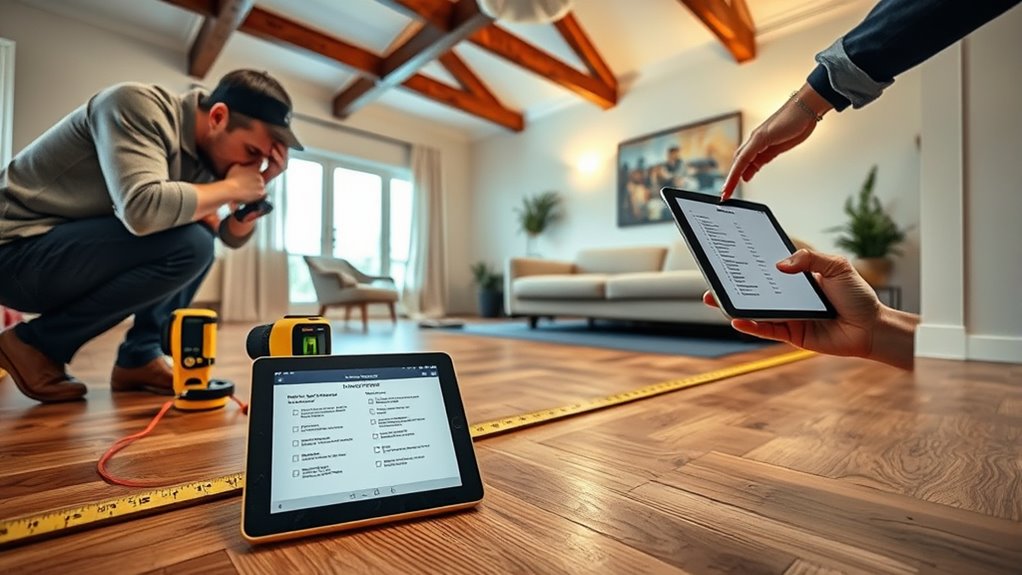
Before you focus on other safety measures, it’s essential to evaluate your home’s structural integrity. Start with a thorough foundation assessment to identify any cracks, shifts, or signs of settling that could compromise stability. A load bearing analysis helps determine whether your home’s load distribution is balanced and capable of supporting future stresses, such as added weight or natural wear. Look for uneven floors, sticking doors or windows, and visible gaps around walls or foundation. Addressing these issues early prevents costly repairs later. If you’re unsure, consider hiring a structural engineer for a professional evaluation. Regular assessments ensure your home remains safe, stable, and capable of withstanding environmental forces over time. Remember, a solid foundation is the key to overall home safety.
Checking Fire and Smoke Safety Measures
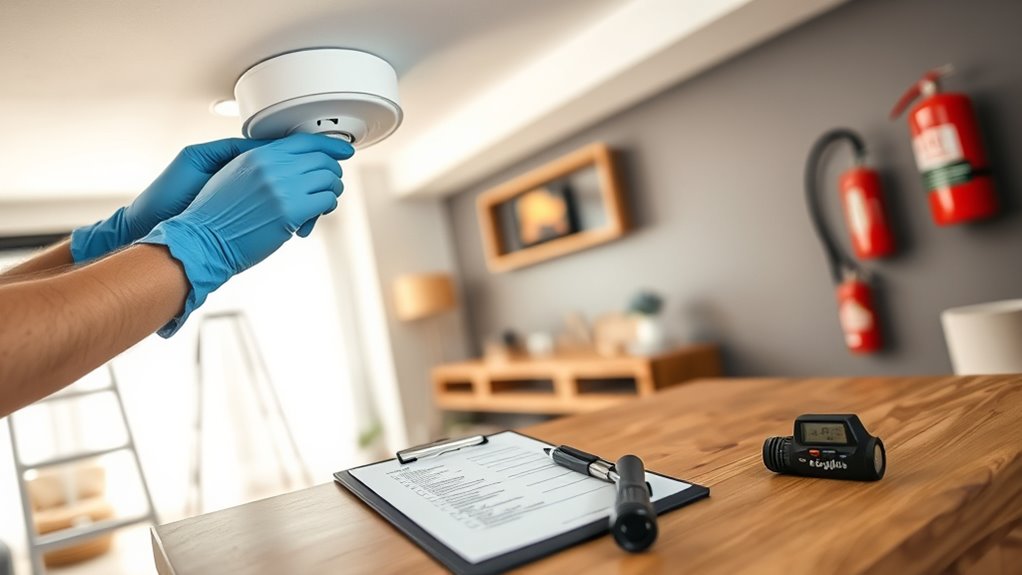
Ensuring your home is equipped with effective fire and smoke safety measures is essential for protecting your family and property. Start by testing your fire alarm regularly to confirm it sounds loudly and clearly. Replace batteries at least once a year, or immediately if the alarm chirps warning of a low battery. Check smoke detectors in key areas like bedrooms, hallways, and the kitchen to guarantee they’re functioning properly. Clean them monthly to remove dust and debris that can impair performance. Consider installing interconnected smoke detectors so that if one activates, all alarms sound. This setup provides early warning throughout your home. Regular maintenance of fire alarms and smoke detectors is a simple yet vital step in safeguarding your household against fire hazards. Incorporating expert voice actors in your safety communications can help ensure your messages are clear and engaging for all household members.
Evaluating Electrical System Safety
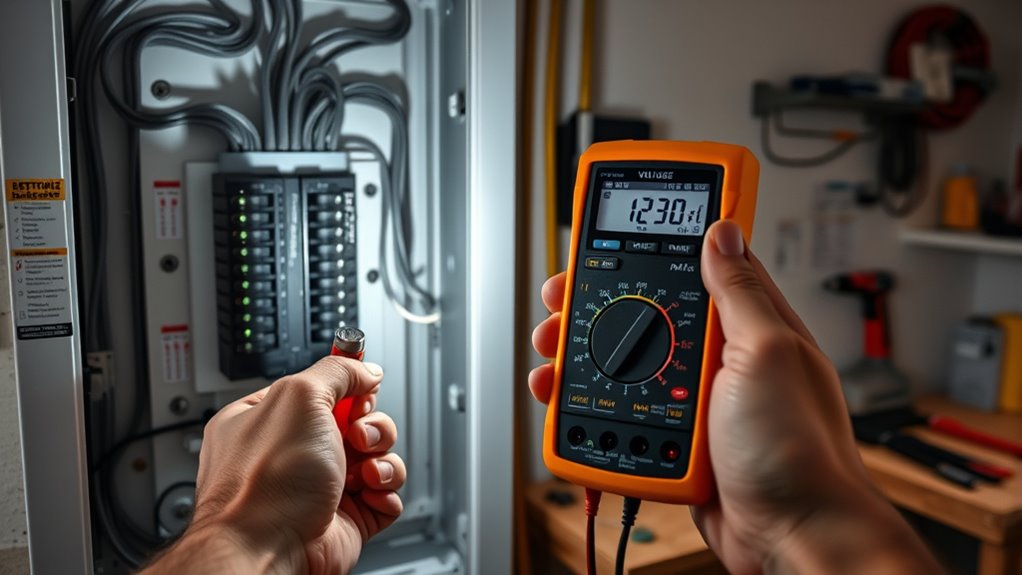
How can you tell if your electrical system is safe? Start by inspecting your electrical wiring for frayed or damaged insulation, which can pose fire hazards. Confirm all outlets and switches are functioning properly, with no scorch marks or loose connections. Check your circuit breakers—if they trip frequently or won’t reset, it signals underlying issues. Modern circuit breakers should trip during overloads to prevent damage, so if yours are outdated or malfunctioning, replace them promptly. Avoid overloading circuits by spreading out high-power devices and using appropriate extension cords. Regularly schedule a professional electrical inspection to identify hidden problems. Maintaining your electrical wiring and circuit breakers helps prevent electrical fires and ensures your home’s safety. Additionally, proper maintenance of electrical components is essential for long-term safety and efficiency.
Testing Emergency Preparedness and Exit Routes
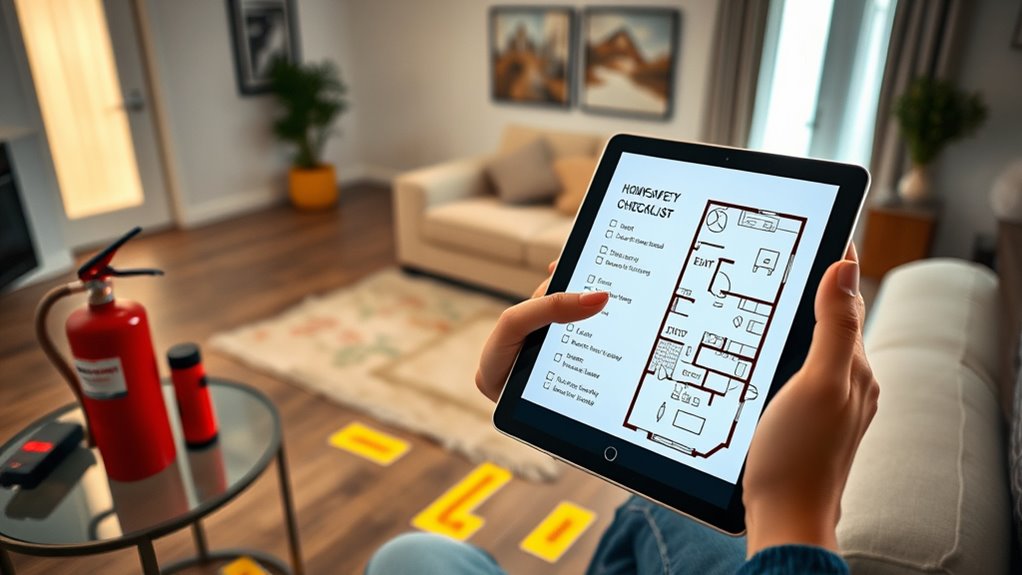
Regularly testing your emergency preparedness and exit routes keeps you ready for unexpected situations. Walk through your escape plans, ensuring all pathways are clear and accessible, especially if garden hazards like overgrown plants or debris block exits. Check that windows and doors open smoothly, and practice quick evacuations with family members. During these drills, look for potential pest control issues that could hinder escape, such as nests or infestations near exits. Update your emergency kit if needed, and confirm that communication devices work properly. Identifying and addressing obstacles during tests helps you respond faster during real emergencies. Consistent practice builds confidence, so you won’t panic and can evacuate swiftly when needed, knowing your routes are safe and effective. Regularly review your home safety checklist to stay current with any new hazards or improvements.
Inspecting Home Security Features
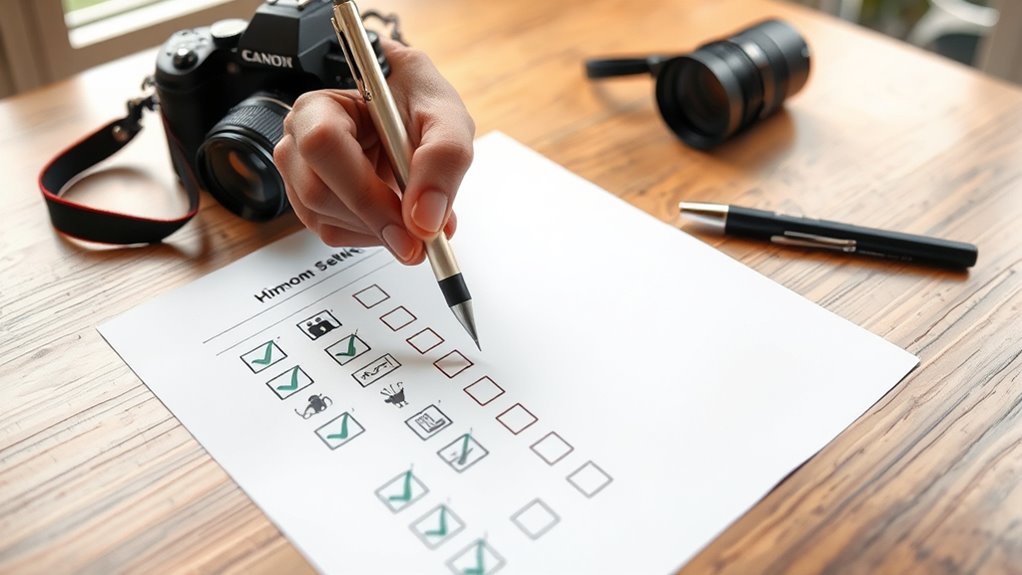
Inspecting your home security features is a vital step in maintaining a safe living environment. Regular checks ensure your smart locks and security cameras function properly. Test your smart locks to confirm they lock and unlock seamlessly, and update their firmware if needed. Review your security camera feeds to verify clear video quality and proper positioning. Check for any obstructions or damage that could hinder operation. Guarantee all devices are connected to power sources and Wi-Fi. Additionally, staying informed about AI in Education can help you understand emerging security technologies that might enhance your home safety.
Identifying Potential Hazardous Materials
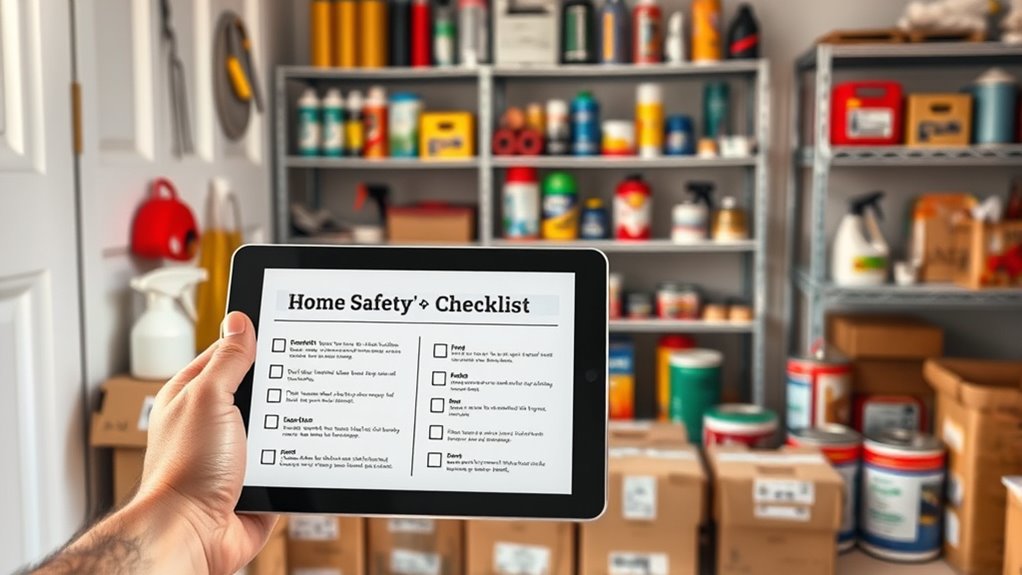
Are you aware of the hazardous materials that might be lurking in your home? Recognizing toxic substances is essential for safety. Start by inspecting common areas for:
- Hazardous chemicals in cleaning supplies, paints, or fertilizers.
- Toxic substances in older furniture, such as lead-based paint or treated wood.
- Unlabeled containers that may hide unknown chemicals.
Many household products contain hazardous chemicals that pose health risks, especially if mishandled or stored improperly. Check storage areas, basements, and garages for these items. Always dispose of chemicals safely and keep them out of children’s reach. Being aware of and identifying potential hazardous materials helps prevent accidents and keeps your home safer for everyone. Additionally, if you own or plan to purchase a Flat Iron Bike, understanding the importance of safe storage and maintenance of electric components can further enhance your home safety.
Monitoring Regular Maintenance and Upkeep
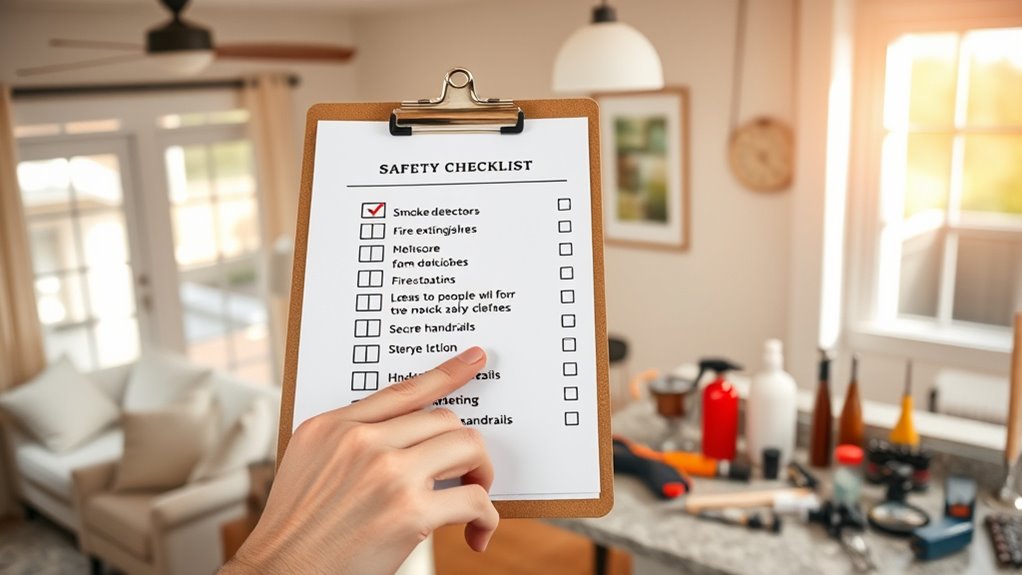
To guarantee your home remains safe and well-maintained, staying on top of routine upkeep is essential. Regularly inspect your garden landscaping to identify any hazards, like loose branches or uneven ground, that could cause injuries. Keep pathways clear of debris and ensure outdoor lighting functions properly for safe navigation at night. Pest control is also crucial—schedule seasonal treatments to prevent infestations that might damage structures or pose health risks. Check gutters and drainage systems to avoid water buildup, which can lead to mold or structural issues. Maintaining appliances, plumbing, and electrical systems regularly helps prevent emergencies. Additionally, understanding the importance of projector contrast ratios can help you optimize your home entertainment area to prevent eye strain and ensure clear visuals. By staying proactive with these tasks, you reduce safety risks and preserve your home’s integrity, making it a safer place for everyone.
Frequently Asked Questions
How Often Should I Conduct a Home Safety Assessment?
You should conduct a home safety assessment at least every six months to identify fire hazards and verify childproofing tips are up to date. Regular checks help you spot potential dangers like faulty wiring or unsecured furniture. After any home renovation or move, reassess immediately. Staying proactive keeps your home safe, allowing you to address fire hazards and childproofing needs before accidents happen, giving you peace of mind.
What Tools Are Best for Measuring Safety Compliance?
You should use a combination of tools like a fire hazard detector, electrical safety tester, and checklist forms to measure safety compliance. These tools help identify fire hazards such as faulty wiring or blocked exits and guarantee electrical safety by testing outlets and cords. A digital camera or smartphone app can document issues for later review. Regularly using these tools keeps your home safe and ensures you meet safety standards effectively.
How Do I Prioritize Safety Improvements Effectively?
You should start with a risk assessment, which reveals that 75% of home accidents happen in familiar spaces. Focus on safety upgrades that address the most serious hazards first. Prioritize improvements based on potential injury severity and likelihood. This method guarantees you’re tackling high-risk areas efficiently, creating a safer environment. Regularly reassess to stay ahead of new risks, making safety upgrades that protect everyone effectively.
Can Professional Assessments Replace DIY Checklists?
Professional assessments can complement your DIY checklists, especially with a smart home and safety technology. They provide expert insights that identify risks you might overlook, ensuring thorough safety. While DIY checks are useful for routine monitoring, professionals can evaluate complex systems like security alarms and smoke detectors more accurately. Combining both approaches maximizes your home’s safety, giving you confidence in your safety measures and allowing for targeted improvements.
What Signs Indicate My Home May Be Unsafe?
You should be alert if you notice childproofing hazards like unsecured cabinets or exposed electrical outlets, which pose risks to children. Also, blocked fire escape routes or broken smoke alarms indicate your home may be unsafe. Studies show that 60% of home injuries could be prevented with proper safety measures. Regularly check for these signs to guarantee your home remains secure and protect your loved ones effectively.
Conclusion
By regularly using this checklist, you’re channeling your inner hero, much like Hercules facing challenges head-on. Staying vigilant guarantees your home remains a fortress, safe and sound. Think of it as your personal shield, protecting what matters most. With consistent assessments, you’ll turn potential hazards into distant memories, so your home stands strong—just like legends of old, resilient and secure for all who dwell within.




